
And it’s on to Disc 3 of this seven-disc compilation — and it looks like we’ve pinpointed the moment when the 80s become, irrevocably, ”The Eighties”…
#1 Duran Duran, ”Hungry Like the Wolf” (1982)
#3 US
Jack Feerick — This was never my favorite Duran2 track — it was ”Rio,” for me, where it all came together — but the things that made the band work are in full evidence; big, muscular bassline, strategic jabs of guitar, sequencers clicking away like a popcorn popper, drums cutting a perfect middle ground between disco propulsion and rock n’ roll swagger, and the whole thing could veer from funky to spacey on a dime.
Dw. Dunphy — I was more into “Save A Prayer,” myself, but who could refuse “Hungry Like The Wolf” while it was playing? Duran Squared was not the instigators of the style movement of pop in the ’80s but they certainly were one of the highest profiled practitioners. It helped that, initially, they were also a really great band. A couple albums down the line they would lose their way for awhile, becoming all style, less substance, and forgettably repetitive. Then the “Wedding Album” exploded them back into the upper echelon.
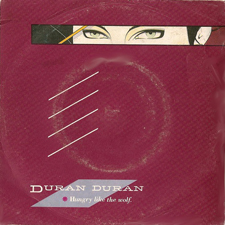 But let’s, for a moment, consider the Duran Duran style, at least for the album this came from — Rio. This series’ header comes from Patrick Nagel’s artwork, and he also did the Rio cover. His line was sleek, his color palette cool and pastel. His subject matter regularly women in states of undress, but so stylized that they were less sexual and more like neon. That doesn’t take away from the substance. Nagel’s work was beautiful but the style was always so far out front, and that causes the body of work to tie him inextricably to the ’80s.
But let’s, for a moment, consider the Duran Duran style, at least for the album this came from — Rio. This series’ header comes from Patrick Nagel’s artwork, and he also did the Rio cover. His line was sleek, his color palette cool and pastel. His subject matter regularly women in states of undress, but so stylized that they were less sexual and more like neon. That doesn’t take away from the substance. Nagel’s work was beautiful but the style was always so far out front, and that causes the body of work to tie him inextricably to the ’80s.
Same with Duran Duran. The first three albums are pop/rock machines running on high octane with nary a sputter, but they will always have the audience thinking ’80s although they have been fairly successful long after that decade.
Feerick — Nagel’s art is iconic, in the old religious sense of the term. It’s as intensely stylized as those paintings of the saints in the Eastern Orthodox churches. That’s our patroness, above, our guiding spirit: Our Lady of the Shoulderpads.
Chris Holmes — I loved Duran Duran’s videos from the Rio album, and this is no exception. It helps that this is a killer song, and about as good as pop got in ’82. It’s clearly more slick than hit music from just two years prior, and yet still feels pretty spacious and organic.
Dan Wiencek — Wait, there was a record that went with this video?
This song was the first big single I heard on MTV — in fact, to my young mind, it seemed to take forever for the radio to catch up and start playing the song. I remember it (the video) being something of a breakthrough, not a quick knockoff nor a passing novelty, but rather something that really tried to pick up and amplify the theme and mood of the song. But honestly, as far as the music (and Duran Duran as a whole) went, I was a “Rio” guy. “Hungry” was good and I wouldn’t change the station when it came on, but it wasn’t go-out-and-get-the-tape good.
Jon Cummings — It’s astonishing today to think that 30 years ago we were asking each other, “Are you a Duran Duran person or a Culture Club person?” I was the former, at least until “Wild Boys” sent things completely off the rails — and while we all know it wasn’t their first-ever single, “Hungry Like the Wolf” was a perfect calling card for the US mainstream. The video, yes … but I didn’t have MTV when the song was popular, so it didn’t dominate my experience of the song. I just had the radio, and those little snippets of the sublime that one could always pull from a ridiculous Duran Duran lyric. “Mouth is alive, with juices like wine” was the one that got me.
Feerick — That the lyrics were utterly meaningless was only a plus, as there was no hint of a narrative to get in the way of the sheer charisma.
Dave Lifton — This series, much more so than during AM Gold, has found the lines between nostalgia, quality, and ubiquity blurred, and this is the perfect example. I know I loved “Hungry Like The Wolf” at the time, and my best friend gave me Rio for my birthday. And, like Jon, I moved away from Duran Duran by the time of “Wild Boys” and “The Reflex” (I can’t recall which came first). But I’ve still heard this so many times over the past 30 years that I feel like I can’t make an honest assessment of it anymore.
Rob Smith — The band’s visual presentation and fashion sense made them an instant cultural force (it helped that they were all as pretty as the little girls they drove crazy), but the song abides, and “Hungry Like the Wolf” is a very good song. What still slays me about it are the guitar riff — that glorious little T. Rexy figure — and Roger Taylor’s drum fills. Much is made about the video (and it was a visually startling four minutes or so — kudos, Russell Mulcahy), but the riff and the little bursts outside the pulse of the song are killer. It’s the little things, I suppose.
Feerick — True story: My Mom used to work the switchboard in a high-end hotel outside Boston that was pretty popular with touring musicians. It was from her that I first learned what an asshole Mike Love was. Anyway: Duran Duran stayed there on what must have been their first US tour — probably their first US show — when they were still virtual unknowns over here. Mom asked me if I’d heard of them, and I thought she was talking about Ian Dury. They were nice guys, she said, very polite, but they seemed to be suffering under the impression that they were much more famous than they actually were; and the hotel staff was snickering behind their backs at the makeup and the purple hair. I can only imagine the comedown for them, as they played to a half-empty club.
And within about six weeks after that, ”Hungry Like the Wolf” was inescapable on MTV and local radio. Don’t you love a happy ending?
#2 ABC, ”The Look of Love (part 1)” (1982)
Topped the US dance chart.
Holmes — And then there’s this. Catchy enough I suppose, but synthesized to within an inch of its life. I know that’s the whole point of this particular flavor of New Wave, but this is really just disco with updated technology. The vocals are also way overwrought. I wouldn’t turn this off if it came up on an ’80s station on internet radio, but I wouldn’t really seek it out.
Smith — Never could get into this. Martin Fry sounds like a whinier Bryan Ferry to me.
Michael Parr — An ABC slam combined with a Brian Ferry slight? Are you purposely baiting Medsker?
Smith — You talkin’ to me? I care very deeply for Bryan Ferry (and his hair. Well, mostly his hair), so I meant no slight. ABC, though? I never thought much of them then, and I don’t think much of ’em in retrospect.
Besides which, I ain’t scared of Medsker. Unless he yells at me.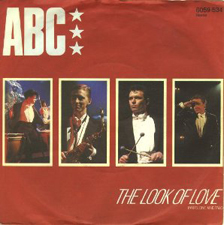
Cummings — Was Martin Fry the most histrionic vocalist of the ’80s? I was enough of an Anglophile in the early ’80s that I chose to like this song when it was out, but I can’t bear to listen all the way through now. Same with “Poison Arrow.” Honestly, how can we sit here 30 years later and justify sending a song into the top 20 that featured this guy caterwauling, “Hip, hip hooray / Yippie-ki, yippie-ki-yay-yay”? The mind boggles.
Lifton — The over-dramatized vocals (especially the call-and-response in the second verse) sounded silly and gimmicky even then, and 30 years haven’t done them any favors.
Feerick — Reviewing the rundown this week, I really wish I’d been hip to Roxy Music way back in the day. It certainly would have helped me to contextualize this stuff at the time. Duran Duran’s debt to Roxy is the more obvious — there are moments on Rio that sound like outtakes from Flesh and Blood — but ABC was taking a page or two from the playbook, too; not just Fry’s voice, but the emphasis on the elegance of the visual presentation.
On the one hand ”The Look of Love” is a silly dance-pop song, and nothing else; but the English have never believed, as Americans seem to, that dance music should be intrinsically dumb. I can hear a level of intelligence and musical ambition in the production and arrangement — especially considering that parenthetical ”(Part 1),” and the track’s place in the album as a whole. Because The Lexicon of Love was definitely, if not a concept album, then a meditation on and tribute to a certain ornate, theatrical strain of disco with antecedents in American records like Peter Brown’s ”Do You Wanna Get Funky With Me?” or Machine’s ”There But For the Grace of God” — a style that made itself influential overseas, but that was largely underground in the US precisely because it was too brainy.
Wiencek — Ever hear Elvis Costello talk about that game he and his friends play, where they try to figure out what songs Elvis Presley would have recorded if he’d lived? Well, look no further: this one has an overdramatic melody and a world-weary spoken interlude. Yes, somewhere in an alternate universe, the King is onstage at the Tropicana, heaving and karate-punching his way through this number, while across the hall the Colonel blows another 300 large on the wheels.
Moral: be glad you only have to listen to ABC doing it.
Dunphy — I like this song much more than “Be Near Me” which had a thoroughly annoying video, but I prefer “When Smokey Sings” of all of ABC’s work. And as Dave Lifton pointed out in our recent Chart Attack! podcast, white Brits were so much more capable of sounding like Motown than Motown was around then. That’s just wrong.
#3 Soft Cell, ”Tainted Love” (1982)
UK #1. Peaked at #8 in the US charts, but spent a record-breaking 43 weeks in the Hot 100.
Lifton — The other thing I said in that podcast that Dunphy mentions was that throughout the 80s, there was always at least one hit a year that was either a cover of Motown, or tried to sound like it. I give Soft Cell a lot of credit for pulling out a song that was relatively unknown here and making it sound modern rather than taking something well-known. I loved it then but nowadays I prefer to hear the original.
Feerick — I like how committed Soft Cell are to maintaining an aura of sleaze. ”Tainted Love” is a perfect song for them to cover — just the adjective, tainted, with its connotations of rot and spoilage; something that will make you sick. Venereal disease, maybe. It’s just an icky piece of work, and magnificently ugly and cheap-sounding, from the wheezy tick of the drum machines to the blown-out CLANK CLANK of the hook.
And how unsavory is Marc Almond’s voice? However much the lyrics paint him as the injured party, he sounds so evil. Insidious. Bitter Almond. Poisonous to the core.
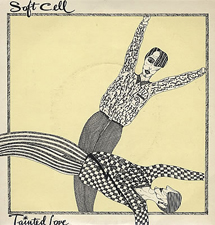 Holmes — Fuck these guys. Give me Gloria Jones or give me death.
Holmes — Fuck these guys. Give me Gloria Jones or give me death.
Smith — What’s not to love? Mid-Sixties Vee-Jay soul dressed up in S&M club leather, slowed down, and treated like a very, very bad boy. Today, it’s a commercial jingle. Go figure. I like the 12″ version, in which it segues into the Supreme’s “Where Did Our Love Go?” — an inspired pairing that was the preferred version played by the radio stations I listened to back then.
Cummings — For 30 years I’ve allowed myself to become furious whenever this gets played on the radio without “Where Did Our Love Go?” attached to it. So I’m pretty mad at the “Omigod” compilers right now. Still, this is the epitome of that usually not-so-glorious trend of ’80s Brit-pop acts updating old tracks with their distinctive blend of synths and off-key mopiness. God love ’em.
Dunphy — Ambivalence, thy name is “Tainted Love.” Sometimes I welcome it and other times I just don’t want to be bothered by it. It is so spare, it could have disappeared altogether or been mashed into the Post Punk movement, but there is a soulfulness toward the middle of it that transcends the cold robotic quality of the first.
And yes, the “Where Did Our Love Go” segue is the superior version by far.
Wiencek — This jumped out at me like a jack in the box when I first heard it — it just stamps itself on your brain like a neon-colored, New Wave branding iron. I don’t have children, but I’d be willing to bet that you could play this for nearly any child and within 30 seconds they’d be humming along to it. Which is a compliment.
#4 Stray Cats, ”Rock this Town” (1982)
Top Ten in both the US and the UK.
Feerick — This has been ruined a bit (for me) by sheer overfamiliarity. I will say that it took me a bunch of listens, back in the day, to realize just what a shit-hot guitarist Brian Setzer is. He just kind of tosses it off so casually that his sheer blinding skill doesn’t hit you over the head.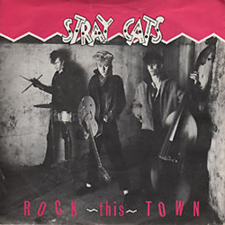
I was a little confused, at the time, at the idea of such shameless 50s revivalists mocking disco and 1974-style fashions as ”square.” If their brand of retro was hip, why knock somebody else’s?
And there’s the temporal disparity. In 1958, only test pilots wore polyester, and a disco record like ”I Feel Love” would have seemed insanely avant garde. So if the Stray Cats are 50s types, shouldn’t their reaction to 70s culture have been more like Hey, cool it with the Captain Video getup, Daddy-O — like, your crazy futuristic jive is flipping my lid something awful, dig? It bugged me, is what I’m saying.
Cummings — In the realm of “never would have made the top 40 without MTV,” we have the curious case of the highest pompadours to hit radio and TV in a quarter-century. Setzer has built a career to be proud of, I suppose, but I’ve never known quite how to feel about the fact that he built it upon a bottomless vat of pomade.
Holmes — The fact that Brian Setzer scored a hit with a rockabilly song in 1982 isn’t the most shocking thing about the Stray Cats. It’s how he managed to sustain that success for as long as he did. But I say good for him. This song kicks ass.
Smith — The pompadours and tattoos and greaser fashion were a fine affectation, particularly at a time when you NEEDED to grab eyes in order to grab ears and hearts and minds. But, damn, they could play. Put on Built for Speed right now and turn the volume up, and it still holds together as a fine rock ‘n’ roll record — maybe not as rich or mind-blowing as the rockabilly forebears they were aping, but a damn good homage.
Dunphy — I’ve had the pleasure of seeing Setzer live twice and he is, in every respect, a real rock star showman. As has already been stated, this probably shouldn’t have been a hit. Rockabilly? Really?
But when you think about it chronologically, this song was only twenty-or-so years out from the original rockabilly movement. Consider that Nirvana’s Nevermind is of drinking age today and that doesn’t feel like a movement that should be far from viable now. For a song like “Rock This Town” to have been such an anomaly then (or Billy Swan’s “I Can Help” in the early ’70s, probably only ten years past a stylistic comfort zone) may save something about how easily we’ve adapted to multiple genres over time.
Lifton — The Stray Cats are from Massapequa, Long Island (which, as another native, Jerry Seinfeld, said, is an Indian term for “By the mall” — Sunrise Mall, to be exact). It’s also three towns east of my hometown of Bellmore, and where my aunt and uncle have lived my whole life. Even more so than Billy Joel, they were ours. It helped that they looked badass and that Setzer could play the shit out of that guitar. “Rock This Town” is still a great song, and I loved the remake the Brian Setzer Orchestra did on The Dirty Boogie.
Wiencek — One of the only things I remember from reading Less Than Zero all those years ago was when one of the coke-addled main characters predicted that the next big trend in music would be rockabilly: “Not the Stray Cats, but real rockabilly.” Don’t know whether B.E. Ellis threw that in as a genuine prediction or as an example of the kind of jackassery people are prone to after a few too many rails, but either way, the portended rockabilly wave never came, for which I for one am grateful. This is a great song by a fun band who, yeah, maybe were kind of a gimmick but they had real humor and style and I don’t see how anyone could dislike this song.
(The only one I could think of who did was Steve Dahl here in Chicago, who wrote a dis of the Stray Cats set to this tune. In retrospect, it seems a pretty sad attempt to get back some of his waning Disco Demolition mojo by trying to pick the next trend to hate. Next time, pick something that actually sucks.)
#5 Thompson Twins, ”Lies” (1982)
Topped the US dance chart.
Holmes — This is one of many songs that pops up on ’80s compilations and has become synonymous with the decade, yet was never that big a hit. This was a huge dance number but peaked at #30 on the Hot 100. Regardless, this is how you do synth pop right. Driving, slightly dark, and a great chorus.
Lifton — Funny, I remember “Hold Me Now” and “Doctor Doctor,” but not this. Everybody who saw their videos said the same thing: “Wait, they’re not really twins?” And that’s when everybody stopped listening to them.
 Dunphy — Right, and then the smartass in the bunch (that’s me raising my hand) tries to tell them it is a Tintin reference, they ask, “What the heck’s a tin-tin,” and it is all downhill from there. This is why I’m not invited to parties.
Dunphy — Right, and then the smartass in the bunch (that’s me raising my hand) tries to tell them it is a Tintin reference, they ask, “What the heck’s a tin-tin,” and it is all downhill from there. This is why I’m not invited to parties.
Feerick — See, in the Tintin translations I’ve read, the detectives, although physically identical, are not twins, or even related — and only one is named Thompson, the other being Thomson; it’s a running joke that they are irritated at being constantly confused for one another.
Wiencek — Um, it’s about lies? I think? If I were old enough to go to dances, maybe I’d feel more kindly disposed to this song. Not that I ever would have danced to it, but it seems a nice tune to nod your head to while standing against a wall, arms folded, trying not to look like you care whether a girl notices you when all you’re thinking about is OH MY GOD I WISH SOMEONE WOULD LOOK AT ME RIGHT NOW.
Cummings — I think my ’80s adoration for the Thompson Twins is one of my great regrets about that decade … musically speaking, at least. Not that I spent that much time on them … but I’m pretty sure they sent more tuneless noise flying up the charts, per capita, than any other act of the era. Why didn’t I recognize it at the time? Musta been the haircuts, I suppose. They were distracting.
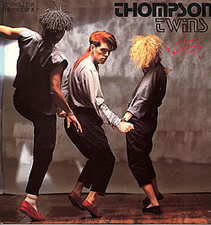 Feerick — Really? What I liked about Thompson Twins the Band is the way they would create this machine-driven music and then humanize it with touches of real musicianship — those rubbery basslines (fretless, if I’m not mistaken), and flourishes of live junkyard-style percussion cutting through the programmed rhythms. It got more ornate on the later records — ”Hold Me Now” has a rhythm bed stuffed with castanets and chimes and and marimbas and tinkerbells and whatnot in every crack and crevice of the song, until it’s actually a little exhausting — but ”Lies” keeps it nicely stripped-down.
Feerick — Really? What I liked about Thompson Twins the Band is the way they would create this machine-driven music and then humanize it with touches of real musicianship — those rubbery basslines (fretless, if I’m not mistaken), and flourishes of live junkyard-style percussion cutting through the programmed rhythms. It got more ornate on the later records — ”Hold Me Now” has a rhythm bed stuffed with castanets and chimes and and marimbas and tinkerbells and whatnot in every crack and crevice of the song, until it’s actually a little exhausting — but ”Lies” keeps it nicely stripped-down.
That, to me, is the essence of the ”Eighties Sound” — a lean, uncluttered hybrid of live musicianship and programming. ”Robot funk,” I like to call it. And this has it.
Dunphy — I didn’t get on board with the Thompsons until “Hold Me Now” so this doesn’t hang on to me as conclusively as it should.
Smith — I liked them better when they were in Talking Heads. Oh, wait, that was Tom Tom Club. Who did this again? Never mind.





Comments